Lighting the Way
A couple of hundred years ago, the Congress of the United States of America could get things done. On August 7, 1789, that august body passed an act establishing and supporting lighthouses.
Mariners and their families rejoiced.
Between 1791 and 1910, the dangerous waters at 74 sites on Chesapeake Bay were illuminated by over 100 cottage, tower and screwpile lighthouses.
Moving ice and shifting sands unseated some of those lighthouses before the 20th century decommissioned the rest. First, automation phased out the keepers. Then, satellites made the lighthouses themselves obsolete. Now 33 Chesapeake lighthouses survive. Some are intact, some moved and a few restored. The rest endure in various stages of decay.
To celebrate National Lighthouse Day, we guide you to 14 lights of Chesapeake Bay and Potomac River — including our newest, Blackistone Lighthouse, erected in 2008. Blackistone and Southern Maryland’s other four lighthouses are open for National Lighthouse Day and offer special events.
Chesapeake Bay Lighthouses1. Concord Point |
Northern Bay
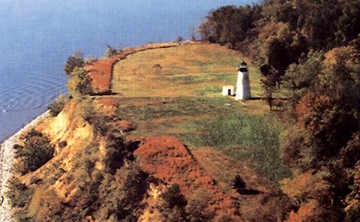
Turkey Point Lighthouse (1833), near the head of the Bay in Elk Neck State Park, is the tallest — at 35 feet — of the 74 lighthouses erected on the Bay. This well-preserved lighthouse was built by John Donahoo, the nation’s finest early lighthouse builder — contractor of 13 stations on the Bay and 31 in his lifetime — in his signature form, a stone tower topped by a light. Its automated light still shines its beam for eight miles. The keeper’s house, occupied until the mid-20th century, is no longer standing.
See it: By water or on a trail walk in Elk Neck State Park.
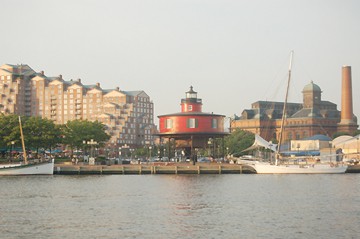
Seven Foot Knoll Light (1855), built at the mouth of the Patapsco River as Maryland’s second screwpile light, is a red iron roundhouse rather than the traditional white wooden octagon screwpile. In 1987, it was moved by barge from its working location to Baltimore’s Inner Harbor.
See it: On Pier 5 in Baltimore’s Inner Harbor, where it keeps company with the Lightship Chesapeake, U.S. Coast Guard cutter Taney, WWII submarine USS Torsk and the 1855 USS Constellation as part of the Historic Ships in Baltimore Museum.
Open daily with free lighthouse admission: www.historicships.org.
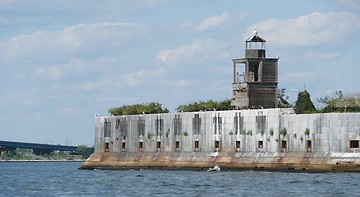
The Fort Carroll Light (1854) was built on the parapet of Fort Carroll, on a man-made island in the middle of the Patapsco River, to protect the water approach to Baltimore. Privately owned, the square wooden tower is in a sad state of disrepair.
See it: To the south when driving east across the Francis Scott Key Bridge.
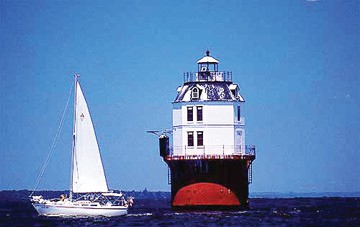
The Baltimore Harbor Light (1904), the last of the working lighthouses built on Chesapeake Bay, was erected only after mishap: the first try tipped over. This deeply drilled caisson lighthouse sits at the mouth of the Magothy River and the entrance to Baltimore Harbor, marking the channel. The two-story white octagon — the keeper’s house — rests on a red steel base and is topped by a black tower, catwalk and light.
Baltimore Light went nuclear for two years in the mid-1960s, making it the world’s first lighthouse so powered, according to the Chesapeake Bay Lighthouse Project: http://cblights.com/lights/
baltimore.html.
See it: At a distance looking north up the Bay from Sandy Point State Park or by water.
By cruise:
• Watermark Tours cruises from Annapolis to Baltimore Harbor plus Sandy Point and Thomas Point lighthouses on Aug. 7 (sold out) and 21; Sept. 4; Oct. 22; all 11:15am-2:15pm. $40 w/age discounts; rsvp: www.watermarkcruises.com/cruisesBayLighthouse.htm; 800-569-9622.
• Chesapeake Lighthouse Tours’ Passage to Five tour cruises from Tilghman Island to Baltimore, Sharps Island, Bloody Point, Thomas Point and Sandy Point lighthouses; $75 w/age discounts; rsvp: www.chesapeakelights.com; 800-690-5080.
See the northern lights: Chesapeake Lighthouse Tours’ Northern Lighthouse Expedition cruises from Tilghman Island to 10 northern lighthouses; $150 w/age discounts; rsvp: www.chesapeakelights.com; 800-690-5080.
MidBay

Sandy Point Shoal Light (1883) stands in 13 feet of water 3,000 feet from shore, beyond the easternmost point of the Broadneck peninsula. The second lighthouse to mark the shoal, it is an octagonal red brick dwelling with a dormered white tower topped with catwalk and light. The base of the structure is surrounded by a metal wall.
Pat Vojtech, connoisseur of lighthouses and author of Lighting the Bay, calls it “one of the prettier caisson lighthouses built on the Bay.”
Sandy Point Light’s topping glory was a handmade crystal lens designed by Augustin Fresnel, who perfected the prisms and reflectors that cast light for miles. Sandy Point’s light shone nine miles. Destroyed by vandalism, the Fresnel lens has an acrylic replacement.
The automated light still shines, but the house itself could use about a million dollars in upgrading after its last improvement in the late 1980s.
See it: From the water, Sandy Point State Park or the Bay Bridge.
By cruise:
• Watermark Tours cruises from Annapolis to Sandy Point plus Baltimore Harbor and Thomas Point lighthouses on Aug. 7 (sold out) and 21; Sept. 4; Oct. 22; all 11:15am-2:15pm. $40 w/age discounts; rsvp: www.watermarkcruises.com/cruisesBayLighthouse.htm; 800-569-9622.
• Chesapeake Lighthouse Tours’ Passage to Five tour cruises from Tilghman Island to Sandy Point, Baltimore, Sharps Island, Bloody Point and Thomas Point lighthouses; $75 w/age discounts; rsvp: www.chesapeakelights.com; 800-690-5080.
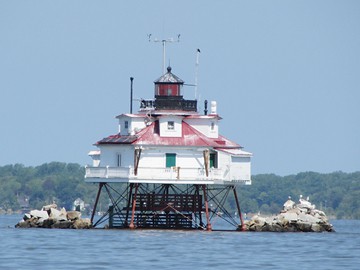
The iconic Thomas Point Shoal Light (1875) is the last screwpile structure on its original site in the Bay, near the mouth of the South River a mile out in the Bay from Thomas Point. In 1975, public protest stopped the Coast Guard from tearing it down. It is listed on the National Register of Historic Places and in 1995 was designated a National Historic Landmark, only one of six lighthouses in the country so honored.
The first Thomas Point Light was built in 1825 on land on a 30-foot high clay bank. After years of erosion, the old house was decommissioned. In 1875, the light we know today was screwed into the Bay bottom a mile offshore. Riprap was added in 1886 as protection against ice.
In excellent condition, Thomas Point is the only intact cottage-style screwpile lighthouse in the country still in its original in-water location. Until it was automated in 1986, Thomas Point was the last manned screwpile lighthouse on the Chesapeake. Its white sector light can be seen for 13 miles and the red sector for 11 miles as Thomas Point continues to light the way to the middle Bay.
See it: By land from Thomas Point Park at the end of the Mayo peninsula (by permit only: 410-222-1777) and by water.
By cruise:
• Annapolis Maritime Museum runs the only tour that enters the lighthouse. Aug. 13 and 14 tours at 9am, noon and 3pm (arrive 30 mins. early). Entering the lighthouse by ladder is strenuous, and no comfort stations are available on boat or lighthouse; age and height restrictions apply; $70; rsvp: www.amaritime.org; 410-295-0104.
• Watermark Tours cruises from Annapolis City Dock to Thomas Point Lighthouse from 4:30pm F-Su thru Sept. 5; SaSu Sept. 10-Oct. 2. $22 w/age discounts; no rsvp.
• Watermark Tours cruises from Annapolis to Thomas Point, Sandy Point and Baltimore Harbor lighthouses on Aug. 7 (sold out) and 21; Sept. 4; Oct. 22; all 11:15am-2:15pm. $40 w/age discounts; rsvp: www.watermarkcruises.com/cruisesBayLighthouse.htm; 800-569-9622.
• Chesapeake Lighthouse Tours’ Passage to Five tour cruises from Tilghman Island to Thomas Point Sandy Point, Baltimore, Sharps Island and Bloody Point lighthouses; $75 w/age discounts; rsvp: www.chesapeakelights.com; 800-690-5080.

Bloody Point Bar Light (1882), a coffee-pot-shaped cast-iron caisson, stands on Bloody Point Bar off the southern tip of Kent Island. It started to lean shortly after it was lit in 1882, tipping five degrees. But it was pushed back up and supported with 760 tons of rock around its base. The lighthouse burned in 1960 and its lens and light were lost. It was later restored and automated. In 1988, the cracked and rusting lighthouse got another modest makeover.
Bloody Point Light still blinks white (nine miles visibility) and red (seven miles) and sounds its foghorn and bell.
See it: By water. It sits on privately owned land.
By cruise: Chesapeake Lighthouse Tours’ Passage to Five tour cruises from Tilghman Island to Bloody Point, Sandy Point, Thomas Point Baltimore and Sharps Island lighthouses; $75 w/age discounts; rsvp: www.chesapeakelights.com; 800-690-5080.
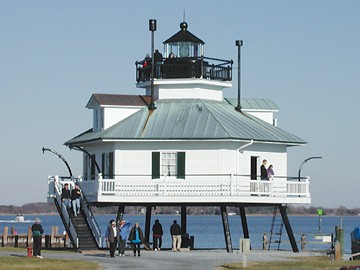
Hooper Strait Lighthouse (1880), a three-story cottage-style house, was relocated from Hooper Strait in Tangier Sound in 1966. At the Chesapeake Bay Maritime Museum in St. Michael’s, it is fully restored as the most popular lighthouse on the Bay, with tens of thousands of visitors each year.
It descends from an 1867 original constructed on the north side of the entrance into Tangier Sound. That lighthouse stood for only 10 years before succumbing to moving ice. The lighthouse was found five miles south sunk in water to its roof line. The lens and bell were salvaged, and the keeper and assistant rescued.
See it: Daily 10am-6pm: $13 museum admission w/age and other discounts: 410-745-2916; www.cbmm.org

Sharps Island Lighthouse (1881-’82), sitting at a 15-degree angle and appearing to be Bloody Point Light’s tilty twin, once marked one of the biggest islands in the Chesapeake Bay. That island has washed away, but Sharps Island Light, located off Black Walnut Point near the entrance of the Choptank River at the end of Tilghman Island, still marks the shallows, its light shining nine miles.
This is the third Sharps Island Light. The first, constructed in 1837, was moved inland after the island lost half of its acreage. In 1866 a new screwpile lighthouse was built, only to be swept away by ice in 1881.
Ice struck again in the 1970s, causing the familiar lean.
See it: Far and wide by water.
By cruise: Chesapeake Lighthouse Tours’ Passage to Five tour cruises from Tilghman Island to Sharps Island, Bloody Point, Sandy Point, Thomas Point and Baltimore lighthouses; $75 w/age discounts; rsvp: www.chesapeakelights.com; 800-690-5080.

Cove Point Lighthouse (1828), a 38-foot truncated tower and keeper’s house built of local brick by John Donahoo in his typical plan. The lighthouse is still active, maintained by a computer connected to the Coast Guard headquarters in Baltimore with a fog detector automatically activated when visibility drops below three miles.
See it: Grounds open daily June through August from 1-4pm at the end of Cove Point Road, off Rt. 2/4 north of Solomons: 410-326-2042; www.calvertmarinemuseum.org.
Lighthouse Day Special: Open for tours conducted by Calvert Marine Museum from 10am to 4pm: free.
The screwpile Drum Point Lighthouse (1883) was built to mark the tricky entrance to the Patuxent River, where it would still be a great help.
“The lighthouse was an off-the-shelf design,” says the museum’s Richard Dodds. “Its ironwork was fabricated in Allentown Rolling Mills of Philadelphia, PA, assembled at Dupont Lighthouse Depot in Baltimore, then shipped to its site for assembly.”
Its light was often darkened during World War II when the area was used for training maneuvers. Service was discontinued in 1962. The 41-ton cottage was rescued by the Calvert Historical Society and eventually moved two miles inland to Calvert Marine Museum in Solomons. The move and restoration to mint condition was supported by the National Park Service, Maryland Historical Trust, the Calvert County government and private donors.
See it: Open daily on the grounds of the Calvert Marine Museum. Museum admission ($7 w/age discounts) gains you full access to this entirely restored treasure: 410-326-2042; www.calvertmarinemuseum.org.
Lighthouse Day Special: Open for tours with activities for children from 10am to 4pm. Hangman’s Faire performs shanties and lighthouse songs from 1pm: $7 museum admission w/age discounts.
Potomac River
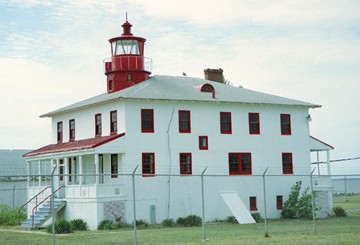
Point Lookout Lighthouse (1830) stands at the end of St. Mary’s County where the Potomac River meets the Bay. John Donahoo built Point Lookout as a white house with red roof and black lantern.
Point Lookout lighted the way for 12 miles in a peaceful era. When the Civil War engulfed the nation, the lighthouses had a new role, monitoring ships entering the Potomac.
At the Point, a federal prisoner of war camp and a hospital were constructed. Nearly 4,000 Confederate soldiers and 500 Union guards died during 16 months, to be buried near the lighthouse. Gravesites were exposed as waters pounded the sandy graveyard, leaving an eerie haunting.
See it: Closed to the public but visible through a high chain link fence at the end of Rt. 5.
Lighthouse Day Special: Open from 10am to 3pm with activities for children, a scavenger hunt and docents leading tours: $5: www.pllps.org.
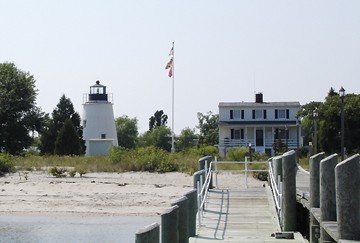
Piney Point Lighthouse (1836) is a squat 30-foot tall conical tower designed by John Donahoo with a later-built two-story keeper’s house adjacent. During World War II, the Navy tested torpedoes in nearby waters and towed a captured German Black Panther submarine to the point for study, then sank it. Piney Point also served as the summer White House for presidents James Monroe, Franklin Pierce and Teddy Roosevelt. An on-site museum details the history.
Piney Point stood idle until 1980, when the Coast Guard transferred ownership to St. Mary’s County and an ambitious restoration program began. The site, a National Historic Landmark, doubles as Maryland’s first historic shipwreck diving preserve.
See it: Leaving Point Lookout and heading north, turn left at the town of Calloway’s only traffic light. The tower appears above the cedars. Grounds open daily, sunrise to sunset; $3 w/age discounts for St Clement’s Island Museum admission: 301-994-1471; www.co.saint-marys.md.us/recreate/museums.
Lighthouse Day Special: The keeper’s quarters open for tours with local artists at work from 10am to 3pm. $3 w/discounts: www.co.saint-marys.md.us/
recreate/PPL.asp.
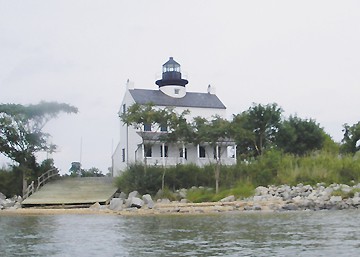
The Blackistone Island Lighthouse (1851) was built on the site of the Baltimore colonists’ first landing, St. Clements Island, by John Donahoo not as his typical conical tower but as a two-and-a-half-story residence with a short tower protruding through the center of its pitched roof. After surviving a Confederate plan to destroy it, it was decommissioned in 1932. Twenty-four years later, a shell from the nearby Naval Proving Ground set the abandoned lighthouse afire. Reconstructed in 2008 by the St. Clement’s Hundred with support from the state and St. Mary’s County, it is Maryland’s newest lighthouse.
See it: At St. Clements Island State Park and by water.
Lighthouse Day Special: Reach the island by water taxi service from 10am to 3:30pm, weather permitting. $7: www.co.saint-marys.md.us/recreate/stclementsisland.asp.
